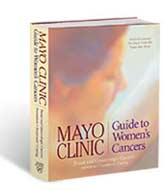Mayo Clinic Guide to Women's Cancers
encontrar mi
|
This book is a well-written, comprehensive resource and is highly recommended. It would be particularly good for any cancer center to keep in their resource/education room. The guide starts off with an introduction to cancer, the basics on cancer rates, risk factors, biology and genetics. The authors do a great job of explaining this complex material in layman's terms.
Part 1 contains eleven chapters devoted to breast cancer, covering the A to Z; including: risk and prevention, screening and diagnosis, treatments including surgery, radiation, chemotherapy, hormone therapy, and treatment of recurrent cancer. The section addresses some less common situations like breast cancer in men or during pregnancy, bilateral disease, and uncommon subtypes. One chapter is devoted to describing various reconstruction techniques.
Part II covers gynecologic malignancies, including: ovarian, endometrial, uterine (sarcomas), fallopian tube, cervical, vaginal and vulvar cancers. Each disease overview includes a description of the cancer, screening, diagnosis, staging, treatment options, follow-up care and estimating survival. Surgical options and common treatments are covered in detail in most of the sections. Part III is entitled "Living With Cancer". This section covers the psychologic and emotional impact of cancer, strategies for communicating with friends, co-workers and children, self-help strategies and sexuality issues. There is one chapter written specifically for partners, which is excellent.
The book includes highlight boxes of helpful facts and common myths throughout, a glossary of terms and a section of color diagrams of anatomy, surgical procedures and the biology of cancer. Scattered throughout the book are stories of real patients, which are very helpful in understanding the human side of these diseases. The stories include women who have survived and some who have lost their battle. Each story presents an equally inspiring tale. Mayo Clinic Guide to Women's Cancers would certainly be helpful to someone with a new diagnosis facing decisions about treatment, but it may also be helpful to friends and family of someone with one of the diseases. This book is very well done and amazingly timely, with up to date information on research findings. I added it to the resource library of our outpatient office right away!

